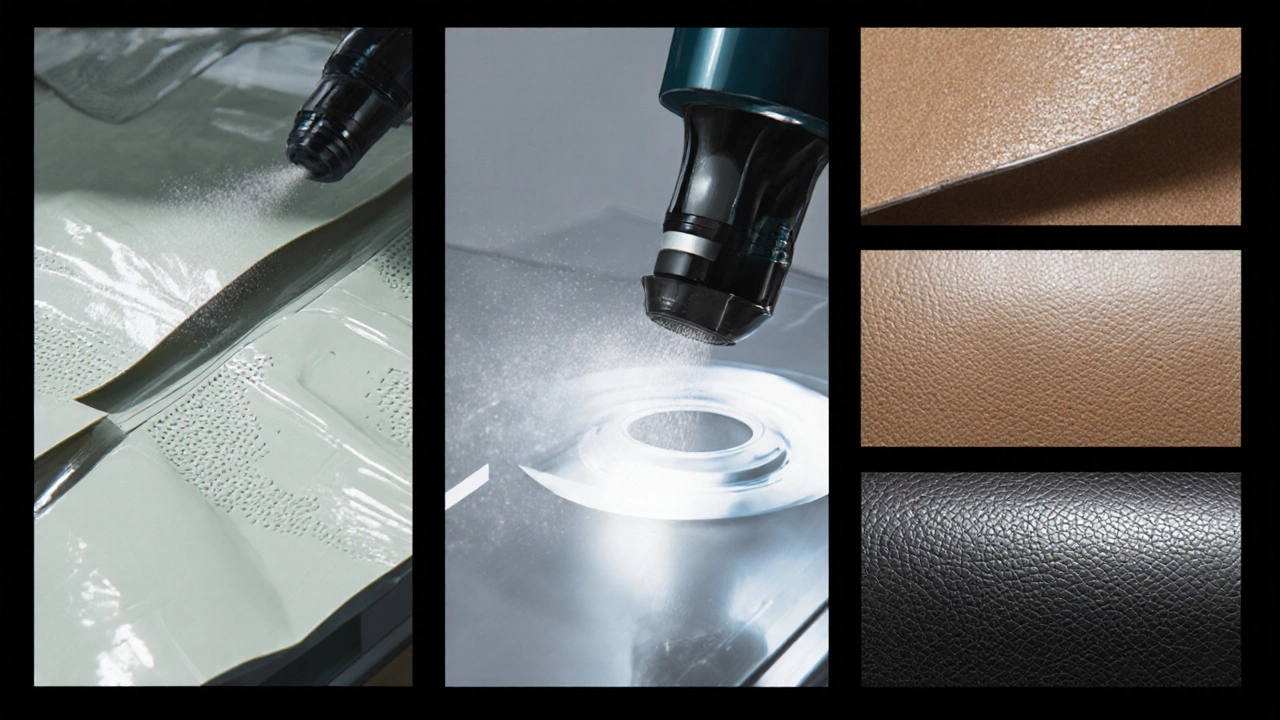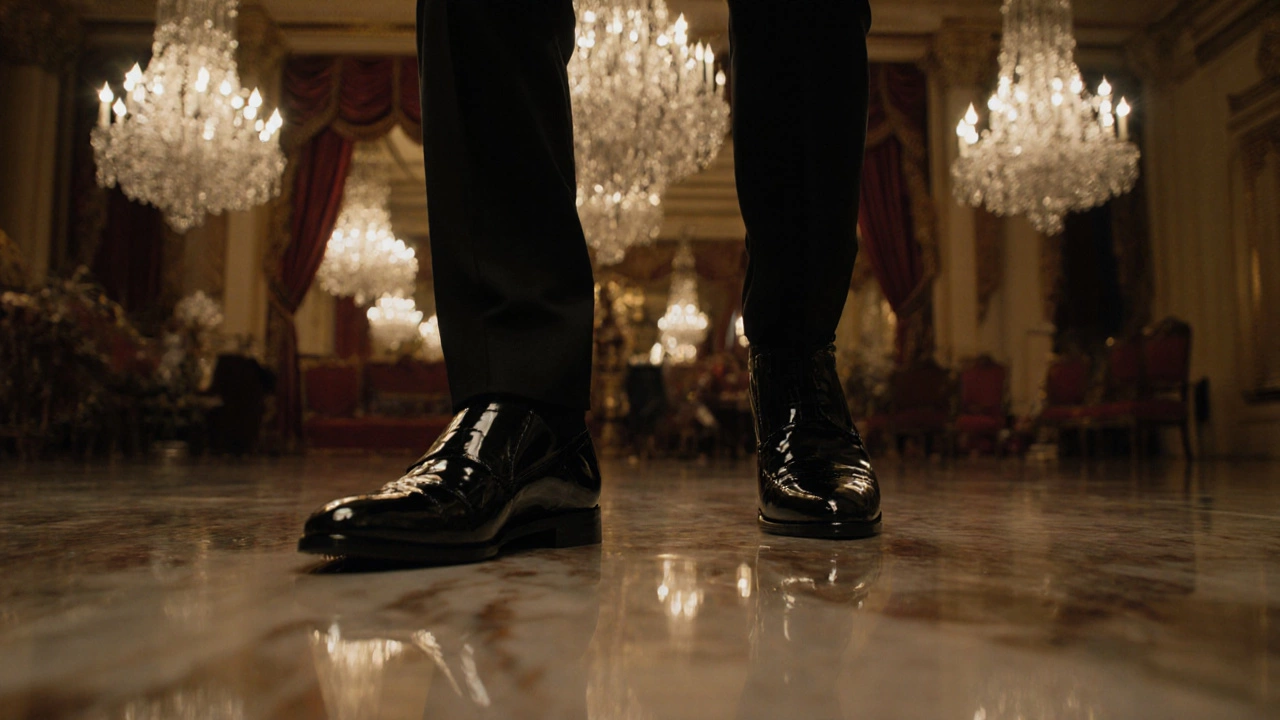Leather Type Comparison Tool
Select which leather types to compare to see their key characteristics side by side.
Leather Comparison
| Material | Finish | Breathability | Durability | Typical Use |
|---|---|---|---|---|
| Patent Leather | High-gloss, mirror-like | Low (plastic coating) | Very good against scratches, but can crack if flexed too much | Formal shoes, evening wear, dress accessories |
| Full-Grain Leather | Natural, untreated or lightly oiled | High | Excellent; develops patina over time | Boots, everyday casual shoes, high-end sneakers |
| Top-Grain Leather | Smooth, often sanded | Moderate | Good; more uniform than full-grain | Office shoes, loafers |
| Suede | Matte, brushed nap | High | Less water-resistant, prone to staining | Casual shoes, low-top sneakers |
| Nubuck | Velvet-like, fine grain | High | Similar to suede, but slightly tougher | Dress boots, casual loafers |
Quick Takeaways
- Shiny, high‑gloss shoe leather is called patent leather.
- It gets its shine from a plastic‑based coating applied to a leather base.
- Patent leather differs from full‑grain, top‑grain, suede, and nubuck in texture, breathability, and care.
- Look for a uniform mirror finish, a distinct plastic feel, and a label that mentions "patent" or "gloss".
- Proper care means cleaning with a soft cloth, using a mild leather cleaner, and avoiding water‑based polish.
What Exactly Is Patent Leather?
When you see a pair of dress shoes that gleam like a polished mirror, the material is almost always Patent leather - a type of leather that has been coated with a high‑gloss, plastic‑based finish. The coating creates a waterproof surface and a reflective shine that traditional leathers can’t match.
The base layer is usually genuine leather - often split or corrected leather - that gives the material strength and shape. Over that base, manufacturers apply a lacquer or polyurethane layer, then polish it to a mirror‑like finish. The result is a shoe that looks sleek, resists stains, and stays shiny with minimal upkeep.
How Patent Leather Is Made
The production process breaks down into three main steps:
- Preparing the leather base: Leather is split, dyed, and often embossed to create a uniform texture.
- Applying the coating: A polyester, PVC, or polyurethane resin is rolled or sprayed onto the surface. Multiple thin coats are added for durability.
- Polishing to high gloss: After each coat dries, the surface is buffed with a high‑speed tumbler and fine abrasives until it achieves that glass‑like shine.
Because the coating is essentially a thin plastic film, patent leather is less breathable than untreated leathers, which is why it’s popular for formal shoes that aren’t meant for long, sweaty wear.
Patents vs. Other Common Leathers
| Material | Finish | Breathability | Durability | Typical Use |
|---|---|---|---|---|
| Patent leather | High‑gloss, mirror‑like | Low (plastic coating) | Very good against scratches, but can crack if flexed too much | Formal shoes, evening wear, dress accessories |
| Full‑grain leather | Natural, untreated or lightly oiled | High | Excellent; develops patina over time | Boots, everyday casual shoes, high‑end sneakers |
| Top‑grain leather | Smooth, often sanded | Moderate | Good; more uniform than full‑grain | Office shoes, loafers |
| Suede | Matte, brushed nap | High | Less water‑resistant, prone to staining | Casual shoes, low‑top sneakers |
| Nubuck | Velvet‑like, fine grain | High | Similar to suede, but slightly tougher | Dress boots, casual loafers |
Notice the stark contrast in breathability and finish. Patent leather’s plastic coat gives it the shine but also blocks airflow, which is why you’ll feel your feet get hotter in patent shoes compared to full‑grain models.

Spotting Real Patent Leather vs. Imitations
Not all glossy shoes are true patent leather. Some manufacturers use faux finishes made from vinyl or synthetic polymers that mimic the look but lack the leather base. Here’s how to tell the difference:
- Touch test: Real patent leather feels slightly supple under the glossy layer, while pure vinyl feels uniformly stiff.
- Edge inspection: At the stitching or heel edge, genuine patent leather shows a faint leather grain; synthetic finishes appear uniformly smooth.
- Water test: Drop a tiny bead of water. On real patent leather the droplet will bead up and roll off; on cheap vinyl it may soak in or leave a faint mark.
- Label clues: Look for words like "patent leather" or "gloss finish". Phrases like "synthetic leather" or "PVC" indicate a fake.
Caring for Patent Leather Shoes
Because the glossy coating is a type of plastic, it reacts differently to cleaning agents than raw leather. Follow these steps to keep your shoes shining:
- Dust regularly: Use a soft, lint‑free cloth to wipe away surface dust.
- Use a mild leather cleaner: Apply a small amount to a cloth and wipe gently. Avoid harsh solvents like acetone.
- Remove scuffs: Lightly rub the spot with a soft eraser or a dab of baking soda mixed with water.
- Polish sparingly: Unlike full‑grain leather, patent leather rarely needs polish. If you must, choose a product labeled for patent leather.
- Store properly: Keep shoes in a breathable shoe bag, away from direct sunlight, which can cause the coating to yellow.
Never submerge patent leather shoes in water. The coating can soften, crack, or peel if it stays wet for too long.
Common Misconceptions
Many people think patent leather is "fake" because of its glossy look. In reality, it’s a legitimate leather finish used for centuries. The term "patent" originally referred to the process being a patented method of coating leather in the 19th century.
Another myth is that patent shoes are always expensive. While high‑end brands use premium leather bases, many affordable fashion lines use split leather with a polymer coat, keeping prices low without sacrificing the look.

Buying Guide: What to Look For
When shopping for shiny shoes, keep these criteria in mind:
- Material disclosure: Brands that list "genuine leather" as the base are preferable to those that say "synthetic" only.
- Coating type: Polyurethane coatings tend to be more flexible than PVC, reducing cracking risk.
- Stitch quality: Uniform stitching indicates good construction and helps the coating stay intact.
- Return policy: Because the finish can be sensitive, a flexible return window lets you test comfort at home.
Consider the shoe’s intended use. For formal events where you’ll be on your feet briefly, patent leather works perfectly. For daily wear, you might prefer a top‑grain shoe with a subtle sheen that breathes better.
FAQs
Is patent leather the same as glossy synthetic leather?
No. Real patent leather starts with a genuine leather base that is then coated, while glossy synthetic leather is made entirely from plastics like PVC or PU without any animal hide.
Can I wear patent leather shoes in the rain?
The coating is water‑resistant, so light rain won’t damage them, but prolonged exposure can cause the plastic layer to weaken. Dry them gently with a soft cloth after getting wet.
How do I know if my patent shoes are genuine leather?
Check the label for "genuine leather" or "full‑grain" alongside "patent finish." Feel the edges: genuine leather will have a faint grain texture under the shine.
What is the best way to clean scuffs on patent leather?
Use a soft eraser or a paste of baking soda and water. Rub gently, then wipe clean with a damp cloth and let dry.
Does patent leather develop a patina like full‑grain leather?
Not in the traditional sense. The plastic coating prevents the natural aging that gives full‑grain leather its character. Instead, it may yellow over time.
Wrapping Up
If you’ve ever wondered why some shoes shine like mirrors, the answer is simple: they’re made of patent leather. Understanding how it differs from other leathers helps you choose the right pair for the right occasion and keep them looking sharp for years. Whether you’re stepping into a wedding, a night out, or a business meeting, knowing the material under that glossy finish gives you confidence in both style and care.
